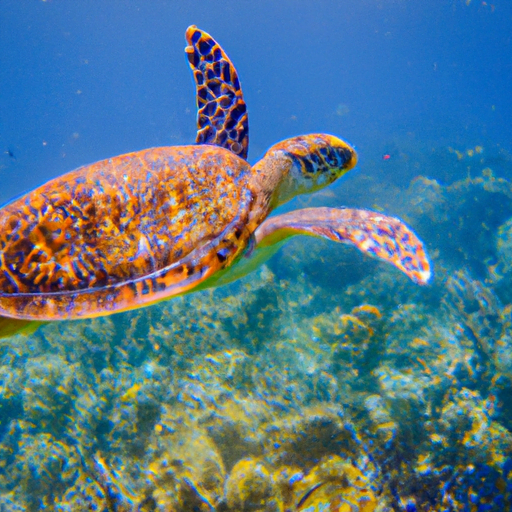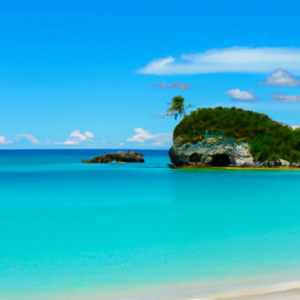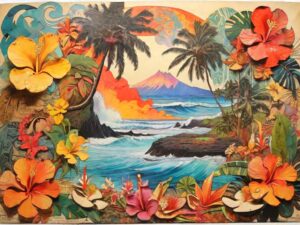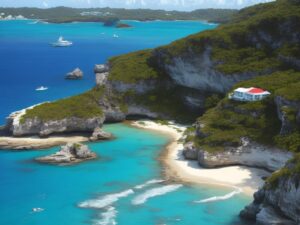Get ready for an unforgettable adventure into the fascinating world of unique Caribbean wildlife! In this article, we will take you on a journey through the diverse landscapes of the Caribbean, introducing you to the remarkable creatures that call this region home. From the vibrant tropical fish that grace the crystal-clear waters, to the majestic birds that soar through the clear blue skies, this guide will provide you with valuable insights on the best spots to witness these wildlife wonders in all their glory. So grab your binoculars and get ready to embark on a thrilling wildlife expedition like no other!
Table of Contents
ToggleCaribbean wildlife
Iguanas of the Cayman Islands
Types of iguanas in the Cayman Islands
The Cayman Islands are known for their vibrant and diverse population of iguanas. The main species that can be found here are the Blue Iguana and the Cuban Rock Iguana. The Blue Iguana, also known as the Grand Cayman Iguana, is endemic to the island and is one of the most endangered iguanas in the world. With its striking blue coloration and unique features, it is truly a sight to behold. The Cuban Rock Iguana, on the other hand, is a larger and more robust species that is commonly found in rocky areas along the coast.
Habitat and behavior
Iguanas in the Cayman Islands can be found in a variety of habitats, ranging from dense forests to coastal areas. The Blue Iguana prefers the dry forests and shrublands of Grand Cayman, while the Cuban Rock Iguana is more commonly found in rocky areas near the shoreline. These reptiles are generally herbivorous, feeding on a diet consisting mainly of fruits, leaves, and flowers. They are also known to be excellent climbers, often seen basking in the sun or seeking refuge in the branches of trees.
Best spots to see iguanas
If you’re hoping to catch a glimpse of these fascinating creatures, there are a few recommended spots in the Cayman Islands. The Blue Iguana Recovery Program, located in Queen Elizabeth II Botanic Park, offers guided tours where you can learn about the conservation efforts being made to protect the endangered Blue Iguana. The Mastic Reserve, a protected area in Grand Cayman, is another great place to observe iguanas in their natural habitat. Here, you can explore the diverse vegetation and keep an eye out for both the Blue Iguana and the Cuban Rock Iguana.
Leatherback turtles of Tobago
Overview of leatherback turtles
Tobago is a renowned nesting site for leatherback turtles, the largest of all sea turtle species. These ancient creatures have been around for over 100 million years, making them a true marvel of nature. Leatherback turtles are characterized by their unique leathery shells and distinctive ridges. They have a streamlined body and powerful flippers, allowing them to navigate the ocean with grace.
Nesting habits and migration
Leatherback turtles have a fascinating nesting behavior. Every year, between March and September, female turtles return to the beaches of Tobago to lay their eggs. They dig deep nests in the sand and lay anywhere from 80 to 100 eggs at a time. After around two months, the hatchlings emerge and make their way to the ocean, guided by the moonlight. Leatherback turtles are also known for their impressive migration patterns. They can travel thousands of miles, crossing entire oceans to reach their feeding grounds.
Best spots to see leatherback turtles
If you’re looking to witness the awe-inspiring sight of leatherback turtles nesting, Tobago offers some excellent opportunities. One of the best spots to see these magnificent creatures is Turtle Beach, located on the northeast coast of Tobago. This beach is a designated nesting site and offers guided tours during the nesting season, allowing visitors to witness the nesting process while ensuring the safety and conservation of these turtles. Other popular locations include Englishman’s Bay and Great Courland Bay, where you can often spot leatherback turtles coming ashore to lay their eggs.
Magnificent Frigatebirds of Barbuda
Description of magnificent frigatebirds
Barbuda is home to the magnificent frigatebird, a majestic and captivating species of seabird. These birds are known for their large size, with a wingspan of up to seven feet, and their striking appearance. Male frigatebirds have a black plumage, while females have a white breast and a brownish neck and head. Their most distinctive feature is the bright red pouch on their throat, which becomes inflamed during breeding season.
Breeding and feeding habits
Magnificent frigatebirds have fascinating breeding habits. Males inflate their bright red throat pouches to attract females during courtship displays. Once a pair has formed, they build a nest in trees or shrubs near coastal areas. The female lays a single egg, which both parents take turns incubating. Frigatebirds are opportunistic feeders, often stealing food from other birds or scavenging from the water’s surface. They are highly skilled flyers, capable of soaring for long periods without flapping their wings.
Best spots to see magnificent frigatebirds
To catch a glimpse of the magnificent frigatebirds, Barbuda offers some excellent viewing spots. The Frigate Bird Sanctuary, located on the western coast of the island, is a protected area specifically established for the conservation of these birds. Here, you can observe the nesting colonies and witness the impressive courtship displays. The Codrington Lagoon National Park is another recommended spot, where you can enjoy a boat tour and get up close to these magnificent creatures in their natural environment.
Grenada’s Underwater Wonders
Diversity of marine life in Grenada
Grenada is a treasure trove for snorkeling and diving enthusiasts due to its rich marine biodiversity. The island’s underwater world is teeming with colorful coral reefs, vibrant fish species, and intriguing marine creatures. From sea turtles to tropical fish, Grenada offers a unique opportunity to explore the wonders of the Caribbean sea.
Popular dive sites
Grenada boasts a wide range of dive sites suitable for divers of all levels of experience. The Bianca C wreck, also known as the “Titanic of the Caribbean,” is a favorite destination for advanced divers. This massive shipwreck rests at a depth of 165 feet and provides a hauntingly beautiful backdrop for underwater exploration. For those seeking shallower dives, sites like Molinere Bay and Flamingo Bay offer stunning coral formations and an abundance of marine life.
Best spots for snorkeling
Snorkeling enthusiasts will find plenty of opportunities to explore Grenada’s underwater wonders. Grand Anse Beach, one of the island’s most popular beaches, is a great starting point. With its calm and clear waters, you can easily spot colorful tropical fish and even encounter sea turtles. The underwater sculpture park at Molinere Bay is another must-visit spot. Created by British artist Jason deCaires Taylor, this unique art installation combines creativity with marine conservation and offers a truly immersive snorkeling experience.
Antigua’s Enchanting Hummingbirds
Species of hummingbirds in Antigua
Antigua is home to several species of hummingbirds, each unique and enchanting in its own way. The two most common species found on the island are the Antillean Crested Hummingbird and the Purple-throated Carib. The Antillean Crested Hummingbird is known for its distinct crest of feathers on its head, while the Purple-throated Carib displays vibrant purples and greens, making it a true delight to behold.
Feeding and mating rituals
Hummingbirds are known for their agility and speed, and Antigua’s hummingbirds are no exception. These mesmerizing birds have a unique ability to hover mid-air and fly in all directions, thanks to their rapid wing beats. They feed on nectar from a variety of flowering plants, using their long, specialized beaks to extract the sweet liquid. During mating season, male hummingbirds engage in an elaborate courtship display, showing off their vibrant colors and performing intricate aerial maneuvers to attract females.
Best spots to see hummingbirds
To catch a glimpse of these enchanting creatures, there are a few recommended spots in Antigua. The Galleon Beach Nature Reserve offers a peaceful and serene setting, perfect for observing hummingbirds in their natural habitat. The Antigua Rainforest Canopy Tour is another excellent option, as it provides a unique opportunity to see hummingbirds up close while exploring the lush rainforest surroundings. Whether you’re a bird-watching enthusiast or simply appreciate the beauty of these tiny creatures, Antigua offers a truly magical experience.
Jamaica’s Colorful Butterflies
Variety of butterfly species in Jamaica
Jamaica is home to a stunning array of butterfly species, boasting over 200 different types. From the vibrant swallowtails to delicate hairstreaks, the butterflies of Jamaica are a testament to the island’s natural beauty. Some of the most iconic species include the Jamaican Swallowtail, the Zebra Longwing, and the Julia Heliconian, each showcasing its own unique colors and patterns.
Life cycle and habitats
Butterflies undergo a fascinating metamorphosis, starting as tiny eggs laid on host plants. After hatching, they transform into caterpillars and go through various feeding stages before forming a chrysalis. Inside the chrysalis, the caterpillar undergoes a remarkable transformation and emerges as a beautiful butterfly. Jamaica’s butterflies can be found in diverse habitats, from lowland forests to gardens and meadows. They rely on a variety of nectar-rich flowers for sustenance.
Best spots for butterfly watching
If you’re eager to witness the colorful butterflies of Jamaica, there are a few locations that promise excellent butterfly watching opportunities. The Blue Mountains, a UNESCO World Heritage Site, offer a pristine and lush environment, providing the perfect backdrop for observing these delicate creatures. The Royal Botanical Gardens in Hope, Kingston, is another recommended spot, with its beautiful gardens attracting a wide range of butterfly species. Wherever you go in Jamaica, keep an eye out for these winged wonders and prepare to be captivated by their beauty.
Flamingos of Bonaire
Flamingo species in Bonaire
Bonaire is renowned for its flamingo population, attracting visitors from around the world. The island is home to two species of flamingos – the Caribbean flamingo and the American flamingo. Both species share similar features, with their iconic pink feathers, long legs, and distinctive curved beaks.
Flamingo breeding habits
Flamingos are known for their unique breeding habits. They form large colonies and gather in shallow water to build their nests using mud and vegetation. The male and female work together to construct the nest, which consists of a mound-shaped structure. After a successful courtship display, the female lays a single egg, which both parents take turns incubating. Flamingo chicks are born with gray plumage and gradually develop their pink feathers over time.
Best spots for flamingo observation
To catch a glimpse of the majestic flamingos in Bonaire, there are a few recommended locations. The Pekelmeer Flamingo Sanctuary, located on the southern end of the island, is a designated protected area and offers an excellent opportunity to observe these elegant birds. The salt flats of Gotomeer are another popular spot where flamingos can often be seen wading through the shallow waters. Make sure to bring your camera and prepare to be mesmerized by the natural beauty of these graceful creatures.
Exquisite Orchids in Dominica
Native orchid species
Dominica is home to a rich and diverse collection of orchid species, each more exquisite than the last. From vibrant colors to delicate, intricate patterns, the orchids of Dominica are a true botanical wonder. Some of the native species found on the island include the Spectacular Orchid, the Lady Slipper Orchid, and the Yellow Fringed Orchid, each displaying its own unique beauty.
Unique adaptations and pollination
Orchids have evolved unique adaptations to attract pollinators and ensure their survival. In Dominica, many orchid species have developed specialized structures to entice specific pollinators, such as bees, butterflies, and hummingbirds. These structures often resemble the shape and color of the pollinator, creating a symbiotic relationship between the orchid and its pollinator. This remarkable adaptation allows for successful pollination and the continuation of the orchid species.
Best spots to see orchids
To witness the exquisite beauty of Dominica’s orchids, there are a few recommended spots to visit. The Dominica Botanic Gardens in Roseau is a must-see, offering a vast collection of orchid species and well-maintained gardens. Exploring the island’s lush rainforests, such as the Morne Trois Pitons National Park, is another great way to encounter these delicate flowers in their natural habitat. Keep your eyes peeled, as orchids can often be found clinging to tree branches or hidden among the forest floor, waiting to be discovered.
Puerto Rico’s Coqui Frogs
Introduction to coqui frogs
Puerto Rico is famous for its vibrant nightlife, and one of the stars of the show is the coqui frog. These small amphibians are endemic to the island and are known for their distinctive and melodic calls that fill the night air. The coqui frog gets its name from the sound it makes, which sounds like “co-kee” or “co-qui,” repeated throughout the night.
Distinctive mating calls
Coqui frogs are renowned for their unique mating calls, which are primarily heard during the breeding season. The males gather in chorus, each calling to attract a mate. This nightly symphony can be quite loud, with the combined calls of multiple frogs creating a captivating and unmistakable sound. The coqui frog’s call has become an integral part of Puerto Rican culture and is often associated with the island’s natural beauty.
Best spots to hear coqui frogs
If you’re seeking the captivating sound of the coqui frog, Puerto Rico offers several destinations where you can experience this magical chorus. The El Yunque National Forest, the only tropical rainforest in the U.S. National Forest System, is well-known for its coqui frog population. Here, you can embark on a nighttime hike and listen to the enchanting calls of these tiny creatures. The Toro Negro Forest Reserve and the Guánica Dry Forest are also excellent locations to immerse yourself in the sounds of the coqui frog and witness their unique mating rituals.
Curacao’s Curious Lizards
Types of lizards in Curacao
Curacao is home to an array of fascinating lizard species, each with its own unique characteristics. One of the most common lizards found on the island is the Curacao Whiptail Lizard, also known as the Curacao Giant Whiptail. This lizard can grow up to 16 inches in length and is known for its remarkable agility and speed. Another notable species is the Curacao Blue Tailed Lizard, a small lizard with a striking turquoise-colored tail.
Habitats and diets
Lizards in Curacao can be found in various habitats, from coastal areas to rocky landscapes and arid regions. They have adapted to the island’s dry climate and have developed unique ways to survive in harsh conditions. These lizards are primarily insectivorous, feeding on a diet consisting of insects, spiders, and other small invertebrates. They play an essential role in controlling the island’s insect populations.
Best spots to spot lizards
If you’re eager to observe the curious lizards of Curacao, there are a few recommended spots to visit. Christoffel National Park, located on the western side of the island, is home to a diverse range of wildlife, including lizards. Here, you can venture on hiking trails and keep an eye out for these unique creatures basking in the sun or scurrying among the rocks. Also, the Shete Boka National Park offers an opportunity to explore the island’s rugged coastline and encounter lizards in their natural habitat.
In conclusion, the Caribbean is not only a haven for stunning beaches and crystal-clear waters but also a sanctuary for a myriad of unique and captivating wildlife. From the resilient iguanas of the Cayman Islands to the graceful leatherback turtles of Tobago, the Caribbean’s wildlife offers a glimpse into the beauty and diversity of nature. Whether you’re exploring the underwater wonders of Grenada or embarking on a bird-watching adventure in Antigua, the Caribbean promises unforgettable encounters with some of the world’s most remarkable creatures. So pack your binoculars, dive into the vibrant depths of the sea, and prepare to be amazed by the wildlife wonders that await you in the Caribbean.





